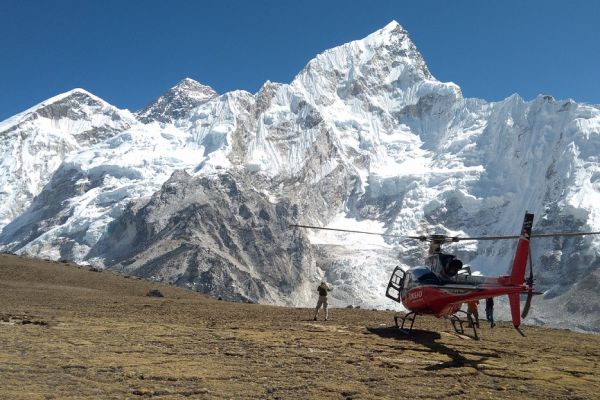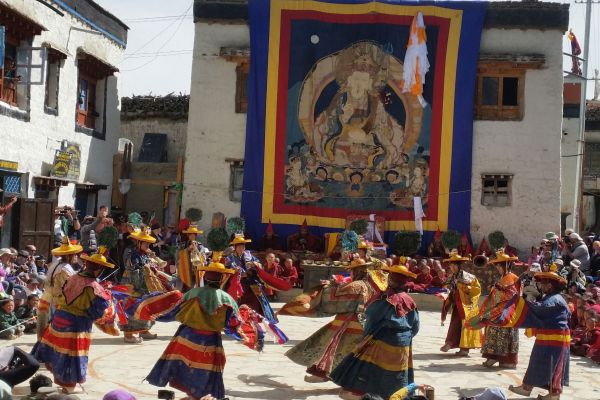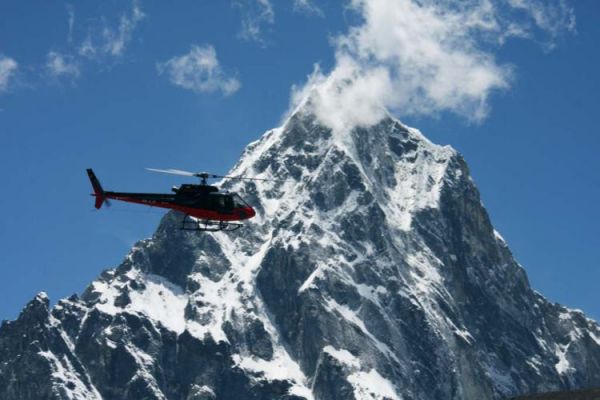- Trip Code : NTE-EBCHT8
- Trip Duration : 4 Days
- Trip Level : Demanding
- Trip Max Altitude : 5600
- Trip Start Location : Kathmandu
- Trip End Location : Kathmandu
- Trip Route : Kathmandu-Lukla-Everest Base Camp
- Trip Best Season : February-June & August - December
Trip Highlights
- Everest Base Camp
- Mt. Pumori, Mt. Everest and its neighbouring mountains
- Khumbu Glacier.
- Sherpa Village.
- Thrilling view of Lukla Airport.
- Gokyo Lake.
- Breakfast at one of the highest helipad; Everest View hotel.
- Fly over Everest Himalayan Range.
Trip Information
If you have a dream of flying over the towering pinnacles of mountains then the Everest Helicopter tour is one of the best tour packages to make your dream come true. Everest Heli Tour is a short and perfect tour for those travellers who have limited time and wants to experience unique adventurous at the top of the majestic Himalayas. This superb Heli tour is an overwhelming adventure, which offers you to get close to the glistering mountains, almost within touching distance to view the enthralling wonders of these parade of towering peaks and take an optimal level of pleasure. This flight journey in the sky will reward you with breathtaking portraits of the Himalayas, glistering snow peaks, tranquil green valleys and many more. Apart from this, the Heli tour also lets you explore and observe the interesting culture, traditions, way of life, religion of the different ethnic groups such as; Rai, Limbu, Sherpa, Gurung, Magar, Thakali, and many more of the Everest region. The Everest Heli Tour is one of the most rewarding and exhilarating space journeys that let you explore the vastness of the Himalayas, which are simply rapturous when you will see them on tip of your nose. This awe-inspiring Everest flight will land on the very popular viewpoints called Pheriche, Kalaphathar and Mt. Everest Base Camp to explore the region and get a real photograph of the surrounding. Experience this amazing Everest Heli Tour with a professional and experienced Heli-Pilot, who is always there to provide emergency services and rescue flight operation for you without any physical challenges.
The Everest Heli Tour in Nepal will provide you wonderful feeling of being close to the magnificent high Himalayas, glittering snow peaks, and the tranquil green hill is really amazing. It is one of the fruitful opportunities to observe almost close nature, for those people who don’t have sufficient time or physically weak but enthusiastic to explore the geographical territories of the Everest region and enjoy the panoramic view of the soaring mountains as well as beautiful Himalayas landscapes very closely. Heli Tour in Nepal provides you with an exclusive opportunity to bask in the grandeur of nature in the various popular destination such as; awesome vistas of snow-capped peaks, breathtaking Himalayas, glaciated passes, quaint village settlements and panoramic landscapes. Aerial sightseeing is one of the famous and unforgettable travel experiences to the Nature lovers, that lets you explore renowned beautiful spot like; Everest Heli tour.
Note:- Above mention information is just the guideline and a standard template of what we provide. The trip can be customized at your request to accommodate your specific requirements.
Short Itinerary
- Day 1 - Arrival in Kathmandu (1,300m/4,264ft).
- Day 2 - Sightseeing in Kathmandu and tour preparations.
- Day 3 - Helicopter tour, fly over Everest Region
- Day 4 - Final departure fly back to your home country
Price Includes
- 3 nights hotel accommodation with breakfast in Kathmandu
- Guided sight seeing tour UNESCO World Heritage Sites of Kathmandu
- Kathmandu to Lukla- Everest-Kathmandu Helicopter Charter
- Sagarmatha National Park Permits fees
- Necessary ground transport service using private vehicle
Price Does not Include
- International Flight Ticket
- Lunch and Dinner at Kathmandu
- Monument fees during the sight seeing
- Tipping for duide and driver expected.
Trekking equipment and clothing needed for this trek
- Normal cotton trouser and tshirt
- During the helicompter tour warm trouser and jacket.
The price per person for the Small group Journey is fixed as stated below. There is also the option of private and tailor made journey best suited for you, your family and friends. The discount is subjected to increase with the number of people in your group. Bigger the group better the discount so group bookings are highly encouraged.
Frequently Asked Questions
- All your departure is guaranteed to run?
- Do I need to tip my guide and porters? How much would that be?
- Can I add extra days to my trek or trip?
- Do you use Yaks and porters on the trek or do we carry all of our own gear?
- Will there be a place to store items clothing not require for the trek?
- What is the weight limit for Remote flight?
- Can I charge my digital camera, mobile or other equipment on my trip?
- Is there any communication while we are on trekking?
- Do you guys have a PAC portable altitude chamber?
- If I am sick can I continue the trek next day after a day rest?
- What if I am badly sick in the Mountain?
- Is Nepal Travel Expedition staff insured?
- What safety measures are in place? What safety equipment do your guides carry with them on the trek to deal with altitude sickness/accident?
- Do your guide have trekking guide certificate from the government tourism center? Have they received first aid training for high altitude?
- What is the weather and temperature like in trekking?
- What is the best session for this trekking?
- What is your cancellation policy?
- Is it possible to reserve a trip now pay deposit later or do I have to pay deposit at booking reservation?
- Do we book own international flights to and from Nepal?
- How much should I pay for helicopter charter?
- In case of cancelled flight due to weather condition, how do we reach Lukla from Kathmandu and vice versa?
- What is the alternative option if my flight to and from Lukla is delayed or cancelled?
- What mode of transportation do you use?
- How much additional money do I need per day for the trek?
- What are the opportunity will I have for the shower along the trek?
- What is the drinking water facilities in the mountain?
- If I am vegetarian, is that a problem?
- Is the food in mountain prepare to international standard in terms of safety?
- What are the Toilet facilities in the tea house or guest house in the trekking route?
- What short of accommodation can I expect in Kathmandu and in the trekking?
- What types of extra document do I need?
- Can I obtain visa for Nepal upon on arrival at airport?
- Will somebody come to pick me up at the airport upon my arrival?
- What types of Shape do I need to be in this trip?
Note:- Above mention information is just the guide line and a standard template of what we provide. The trip can be customize at your request to accommodate your specific require programmed the timeframe for the trip.
Trip Note:- During the trip you might face different different problems such as weather, local politics , transport or a multitude of other factor that are beyond our control could bring change in the programmed. However every unlikely that the itinerary would be substantially atered, if alternative way is necessary, then the tour leader will take decision that the best alternative option. We try to make understand everything clear that we can to minimize its effect but we can not ensure unseen result of changes or delays.
Why this trip make different?
Nepal Travel Expedition works closely with One of the main supporter's Charity service in Nepal. And contribute 10% of the tour cost for Orphan Childrens (sherpa Outdoor Foundation) We support them in many different ways.
Donation and Charity!
Nepal Travel Expedition donates 10% of its annual revenue to Sherpa Outdoor Foundation Orphan Children Home Which is Located in Lalitpur one can visit while you are in Nepal after or before the trip. We support Children's for Food, School, Clothes, Medicine also supporting stationery materials to Government School which is located at Lamjung district trying to build a library for them where they could find a different book to read. For this project, we are trying to collect donations.
Sponsorship and Partnership (volunteering programmed)
One of the major activities of Sherpa outdoor Children home in Lalitpur is fully conducted and collaborate with Nepal Travel Expedition and sister concern organization Nepal wildlife safari. The Volunteering concern programmed delivered by Nepal Travel Expedition and Sherpa Outdoor Foundation aims to mobilize a team of experts and interested individuals as an economic measure in providing human capital for education, health, community to share teaching skill various Government school in a different part of the country and community to delivered humanity skills also in our children home.




